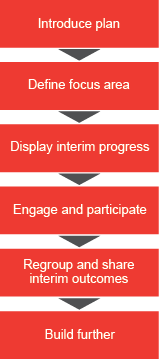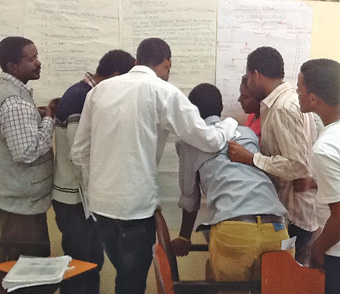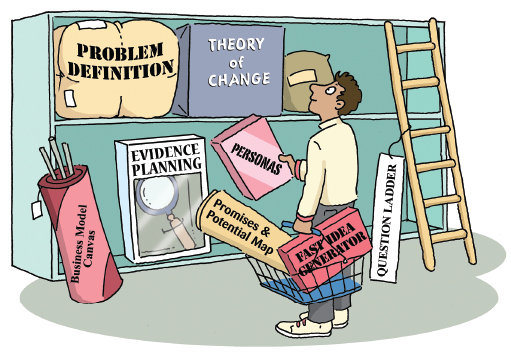Use 'Print preview' to check the number of pages and printer settings.
Print functionality varies between browsers.
Printable page generated Thursday, 20 November 2025, 4:39 PM
Creative Workshop
Introduction
This module will support your understanding and use of the Creative Workshop Tool from the DIY Toolkit. You should look at the Creative Workshop Template which can be found on page 83 of the DIY Toolkit, before working through the module. You will find it helpful to have a printout of the Creative Workshop Template with you while you work through this module.
Many of the complex challenges that we face in development and social enterprise could benefit from fresh thinking and a more imaginative approach. Bringing people together to focus on thinking differently about a specific problem can help to achieve new breakthroughs, or at least understand the elements of the issue in more detail. A Creative Workshop is a tool that can be used to enable this process of collaborative innovation.
A Creative Workshop can also improve your credibility, and that of your organisation, by demonstrating that you value input from other stakeholders, and that you are fair, ethical and transparent.
This module shows you the steps involved to plan and deliver a Creative Workshop. The template for this tool is particularly flexible, and you should expect to adjust the timings and activities for your own needs. The example given uses Personas (page 74 of the DIY Toolkit) as a focus; however, you are likely to produce a different version of the template for each Creative Workshop you run.
Learning outcomes
After studying this module, you should be able to:
- describe why you would use a Creative Workshop (SAQ 1)
- recognise and understand the key steps in planning a Creative Workshop (SAQ 2)
- plan a Creative Workshop (SAQ 3)
- evaluate and select other DIY tools to facilitate key steps for a Creative Workshop (SAQ 4).
1 When you might use a Creative Workshop
A Creative Workshop provides an opportunity to bring together key people to create fresh thinking about an idea. It is used in many different scenarios, for example:
- when a project is in the initial design phase
- when ‘business as usual’ is not working and standard solutions have failed
- when there is a new opportunity to do things differently.
A Creative Workshop is distinguished from other workshops by its focus on providing a supportive environment for participants to share new and innovative ideas openly.
A Creative Workshop can be used to:
- generate and explore a range of ideas
- select and build upon the best ideas
- create a clear vision for how ideas can be realised
- do all of these things!
You set the purpose and boundary of your own Creative Workshop.
Holding a successful Creative Workshop takes careful thought and planning. A poorly run workshop is a dispiriting experience for all involved. The facilitator needs to be sure that the right people are in the room, and that they have the space and support they need to think playfully and inventively about potentially serious topics.

1.1 What’s the purpose?
You will need to have a clear purpose for the Creative Workshop in order to achieve your objectives and persuade people to attend. Being able to explain your purpose succinctly to colleagues is an important first step. Get some informal feedback as to whether the Creative Workshop is a good idea before committing to it. You could do this by asking the following questions.
- What is the exact challenge you wish to solve, encapsulated in one sentence?
- Would your target participants be excited to attend?
- Are you focusing on the most important issue, or are there other ideas to discuss?
Emphasise the Creative Workshop’s focus on solutions, as people are more likely to attend if they know there will be a clear output.
Case Study 1: A Creative Workshop in health education
Feven is a project manager delivering two masters programmes for health strengthening in a sub-Saharan country. The programmes are delivered through blended learning. Students, who are health managers in the health system, study independently, but attend a university for one week in four for teaching. The rest of the time they continue in their health management roles. However, there are problems with the delivery format of the masters’ programmes.
Students complained that they didn’t have enough time to study the modules effectively because of the demands of their jobs, and their line managers complained that their commitment and effectiveness in their jobs was compromised. The universities and academics were also struggling to timetable the teaching every four weeks.
Feven organised a Creative Workshop and invited representatives from the Ministry of Health, students’ line managers, the universities, teachers and students. Over the course of one day the Creative Workshop process was followed and some new ideas emerged. These included giving students study time and enabling students to delegate more work to colleagues, but the most popular suggestion was to shift the programme from a two-year delivery to three years.
This was quite a radical departure, but was welcomed by all stakeholders. The Ministry was reassured that its investment in producing the programmes would lead to improvements in health service delivery because students now had sufficient time to study without compromising their responsibilities at work. This also pleased their line managers, and the universities had more time to deliver the programmes in a robust way, placing less strain on their academics.
On reflection, Feven said that the greatest benefit of the Creative Workshop was that stakeholders heard the perspectives of others, and also appreciated that unless each stakeholder’s concerns were addressed, the project aim and many of its objectives would be undermined. The Creative Workshop provided an opportunity for reflection, and to reorientate the project so that it could deliver the intended benefits and increase the commitment of all stakeholders.
Activity 1
In the text box below, reflect on a situation in your work when this tool would potentially have worked for you. Why do you think it might have worked?
Discussion
A Creative Workshop can be particularly useful when there is a growing awareness among stakeholders that existing approaches are not working and the solutions, if not directly failing, are not delivering the desired outcomes. You might have thought about generating ideas for a new project, or a project extension, or any number of other challenges.
1.2 Who should attend?
Gathering all relevant stakeholders together ensures that there will be many ideas, because a wide variety of perspectives will be heard. People are more likely to engage with the ideas emerging from the Creative Workshop because they have been involved in forming them. Resistance is also likely to be lower because there will be no surprises.
Identifying relevant stakeholders requires careful thought. You need to have representatives from all stakeholder groups, both internal and external, and to think about the balance between them. This may be the first time diverse stakeholder representatives have come together, for example, from government, non-governmental organisations, donors and user groups, and you will need to manage all their expectations. This can be a challenge!
One way to ensure you have a workable and effective balance of people is to differentiate stakeholders into primary and secondary stakeholders, where primary stakeholders are those directly affected by the focus of the Creative Workshop, and secondary stakeholders are indirectly affected. You could use the People & Connections Map from page 68 of the DIY Toolkit to help this process.
Key point
Getting the right mix of stakeholders together in a Creative Workshop brings a wide variety of perspectives on an issue, ensuring that there will be many ideas generated and shared.
2 Planning a Creative Workshop
Before the workshop, you will need to think about practicalities such as finding a good venue, with the right facilities, in a location that the majority of participants (especially the primary ones) will find easy to access. You want to encourage openness, so think about whether the venue is a neutral one for all partners. Make sure you have allowed for any special requirements such as wheelchair access, and make arrangements for food and drink. Ensure that all participants know the location and timings, and suggest that they dress casually if this is appropriate.
Activity 2
In the text box below, reflect on when you are at your most creative and innovative, and then think about what influencing factors you could replicate at the Creative Workshop. For example, I feel creative when I am relaxed and comfortable, so a very formal environment for a workshop wouldn’t work for me. You might also find it helpful to think about when you aren’t feeling creative. What do you need to avoid?
Discussion
Your answers will be personal to you, although there are some universal comfort factors such as being hydrated and having enough fresh air. Perhaps you’re at your most creative and innovative when you’re walking; in other words, not when sitting at a desk. Many people become creative and animated when talking with others about a subject that interests them. Talking from your own perspective helps you to work out the detail of what you think and feel, and hearing other perspectives either reinforces, expands or challenges that, and encourages you to think about your own perspective more deeply.
So, you could give participants at your Creative Workshop time to walk around, perhaps provide tea and coffee breaks outside the building so that they can get some fresh air. This will also give them an opportunity to mingle and chat informally, and take some exercise to foster creative thinking.

There are six steps in planning a Creative Workshop, as shown in the flow diagram in Figure 3. A clear step-by-step schedule of activities and timings for each activity will help to make the planning a success. During the Creative Workshop itself you can manage your available time and decide how long to dedicate to each step.

2.1 Introduce plan
If the Creative Workshop is to be successful, its purpose and structure need to be understood by all participants. Help people to focus on a productive day by introducing the purpose and structure of the Creative Workshop. Outline the problem that you have come together to solve, and emphasise the importance of thinking inventively to move away from the current position. Reassure participants that this is a safe environment for sharing ideas and that nothing is off limits, however silly it might seem. You could illustrate this with an example of some particularly playful creative thinking.
If you are really organised you could also send out a summary with the joining instructions for the workshop. Box 1 provides a checklist to ensure you cover what you need.
Box 1: Creative Workshop checklist
- What is the purpose of the Creative Workshop?
- Who is attending the workshop? (This might be roles rather than names.)
- What is expected from participants? (Think about both preparatory work and during the workshop itself.)
- How will participants work together?
- How will they share their ideas?
- What materials and tools do you intend to use? (Provide necessary props like flip charts, marker pens, sticky notes and sticky tape.)
- How will you capture the results?
- What will happen after the workshop to make sure ideas become actions?
2.2 Define focus areas
Group people together to define the focus areas that they will explore. Because you are likely to have multi-stakeholder participants, you need to decide whether it is best to allow similar stakeholders to work together – for example, all donors – or to mix up their knowledge and skills across groups. The former is likely to give rise to a voicing of interests around the issue, which may be a good starting point for sharing the different perspectives of stakeholders. The latter is likely to give rise to a broader and less positional voicing of interests, which may be good for moving towards solutions.
Think about how you will ask groups to capture their ideas; for example, using flip charts or sticky notes. Whilst the groups are working, go round and listen to the sorts of ideas that are being generated. Don’t be afraid to redirect groups that are going off topic – a good definition of a focus area should be short and to the point.
2.3 Display interim progress
Here, the groups bring their ideas together. The focus areas could emerge clearly or you might be able to identify three or four broad themes from diverse ideas, in which case you can pin those headings around the room and ask each group to post their sticky notes under each heading. If you have asked the groups to capture ideas on flip charts, pin these up together.
2.4 Engage and participate
Continuing to work in the same groups, ask the participants to begin to think creatively around the focus areas. Remind people that this is about generating ideas rather than fully defined solutions.
A Creative Workshop is a good forum to both collect and share different stakeholder experiences. Therefore, allowing time and space for people to share their thoughts is essential, and so is the need for others to listen. A certain degree of informality such as that shown in Figure 4 can be useful for encouraging a free and open exchange of ideas. Don’t be afraid to assert your role as facilitator to make sure that everyone plays an equal part in the activity.

It is a good idea to let participants move around if they wish, to help them to re-energise, spark short discussions and avoid groups becoming too embedded in a single perspective. Their purpose here is to understand the ideas of other groups and expand on their best idea in light of the ideas of others.
Case Study 2 gives one suggestion for how you can help people to think in new ways as well as encourage participants to voice their ideas, no matter how unusual.
Case Study 2: Encouraging creative thinking
Florence was facilitating workshops with non-governmental organisation (NGO) country teams, with the purpose of planning expansion and developing new business. The staff worked in small groups. Each group was given a different picture from a newspaper or magazine to prompt curiosity. They were then asked to think of any words that came to mind from the picture and write them on a flip chart.
At this point, participants did not know where the exercise was leading. The flip charts were then distributed among the groups so that each group worked with a different list of words. Florence then asked the groups to relate each word to the overall purpose, which in this case was how to develop new business and expand.
What the group found surprising was that any word could be taken and given a meaning relating to the problem. This led to some creative and unexpected suggestions, which led to further discussion, as well as much laughter. Nothing was off limits and people were comfortable about being playful enough to generate genuinely new ideas.
2.5 Regroup and share interim outcomes
Bring the groups back together and ask a representative from each one to present their best idea. Check with each group that everyone is happy that their representative covered all the important points that were raised.
2.6 Build further
Still in one group, decide how best to move forward with the ideas created. You can begin this by asking the following questions, encouraging participants to move beyond their original outputs and to critically consider the merits of each idea.
- What is similar and different about our ideas?
- What does this tell us?
- What is striking about what we have captured so far?
- What do we want to work with further?
The group could vote on the best idea as the one all stakeholders will develop going forward. It might be possible to blend some of the ideas, or even take forward two or three. Further development is likely to be with the assistance of other DIY tools such as a Business Model Canvas, which can be found on page 20 of the DIY Toolkit.
If this session brings you to the end of your workshop, make sure everyone knows what will happen as a result of the discussions, and who is responsible for taking ideas forward to become actions.
Activity 3
Put these six steps in the order in which they were presented in the text:
Two lists follow, match one item from the first with one item from the second. Each item can only be matched once. There are 6 items in each list.
Introduce plan
Define focus areas
Display interim progress
Engage and participate
Regroup and share interim outcomes
Build further
Match each of the previous list items with an item from the following list:
a.Step 3
b.Step 1
c.Step 4
d.Step 5
e.Step 2
f.Step 6
- 1 = b,
- 2 = e,
- 3 = a,
- 4 = c,
- 5 = d,
- 6 = f
2.7 Plan your own workshop
You are now in a position to plan your own Creative Workshop following the six steps you have just worked through.
Activity 4
Draw up a plan for the six steps of your own Creative Workshop, making notes for each of the headings.
You might find the checklist below helpful.
- I can describe the purpose of my workshop in one clear sentence.
- I have asked or intend to ask my colleagues for informal feedback on my workshop plan.
- I have a list of stakeholders that I want to invite, representing as many perspectives as possible on the issue.
- I have thought about the venue for the workshop, and all the things I can do to make it a good environment for thinking creatively.
- I know how I will group people together at the workshop in the most appropriate way for the outcome I am seeking.
- I know what resources I will need to enable the groups to capture and feed back ideas.
- I have allowed time to present back and sum up ideas.
- I have noted the need to make sure everyone understands what actions will be taken as a result of the workshop.
Discussion
The content of your Creative Workshop will depend on the challenge that you want to address. If you can tick off each of the items in the checklist, the chances are that you have made a good start. If not, go back and fill in the gaps.
3 Evaluate and select other DIY tools
The Creative Workshop as presented here and in the DIY Toolkit is a framework planning tool. When it comes to delivering the Creative Workshop, you can populate the steps with your own activities or you can use other DIY tools, as the template has done with Personas. Below are some suggestions of DIY tools that you might use at each step of the Creative Workshop.
Personas – I want to know the people I'm working with by visualising their key characteristics (use when deciding focus areas and where it is helpful to know who the session is focused on).
Promises & Potential Map – I want to know the people I'm working with by defining how my offering is new to them (use when sharing interim progress, regrouping and sharing progress, as well as building further).
Business Model Canvas – I want to develop a clear plan on how to grow my idea into something bigger (use when building further).
Theory of Change – I want to clarify my priorities by defining my goals and the path to reach them (use when building further).
Figure 5 represents how you can ‘shop’ for tools to support and enrich your Creative Workshop.

Activity 5
Decide which of the DIY tools are most appropriate for your purposes. The nine most downloaded DIY tools have been included in the list below to help you to customise your Creative Workshop. Click on ‘Reveal discussion’ underneath each tool to read a little about it. If you decide it will be useful, make a note of it. Select at least three tools.
a. Evidence Planning
Discussion
I want to look ahead by defining the outcomes from my work.
b. SWOT Analysis
Discussion
I want to develop a clear plan by evaluating how I am doing and what my options are.
c. Business Model Canvas
Discussion
I want to develop a clear plan on how to grow my idea into something bigger.
d. Building Partnerships Map
Discussion
I want to develop a clear plan for working with other groups that have the same vision as me.
e. Problem Definition
Discussion
I want to clarify my priorities by focusing on key critical issues.
f. Theory of Change
Discussion
I want to clarify my priorities by defining my goals and the path to reach them.
g. Question Ladder
Discussion
I want to collect inputs from others by getting to the heart of what motivates people.
h. Personas
Discussion
I want to know the people I'm working with by visualising their key characteristics.
i. Fast Idea Generator
Discussion
I want to generate new ideas by thinking differently.
I hope you now have a selection of tools with which you are happy. Remember: if you find that any of the tools do not meet your expectations, you can choose another.
Summary
This module has described why and when you would use a Creative Workshop and explained the steps in planning one, bringing people together to focus on thinking differently about a specific problem. It has guided you in planning your own Creative Workshop, and suggested other DIY tools you might use to deliver it.
Self-assessment questions (SAQ)
SAQ 1
Think of three reasons why you should identify and analyse your stakeholders and invite representatives to your Creative Workshops.
Discussion
Are these amongst your reasons?
- It ensures that lots of ideas will be generated.
- It ensures that a variety of perspectives will be heard.
- Stakeholders are more likely to engage with ideas they co-created.
- Resistance will be lower because there will be no surprises.
- It increases your credibility and that of your organisation.
- It’s fair.
- It improves your chances of a successful Creative Workshop.
SAQ 2
Identify whether the following statements about planning a Creative Workshop are true or false.
a.
True
b.
False
The correct answer is b.
Discussion
The correct answer is false – it’s on thinking creatively and generating ideas. The hard work is likely to come afterwards when the ideas are realised.
a.
True
b.
False
The correct answer is a.
Discussion
The correct answer is true – you can’t plan for every conceivable occurrence, so you will need to be flexible to accommodate what happens organically.
a.
True
b.
False
The correct answer is b.
Discussion
The correct answer is false – whilst Creative Workshops should allow people to say what they think, this is not so they can feel better. The focus is on co-creating solutions, not ranting.
a.
True
b.
False
The correct answer is b.
Discussion
The correct answer is false – a Creative Workshop is not a pacifier. Some things have to change if it is to be a true success.
SAQ 3
a.
Planning
b.
Drawing
c.
Networking
d.
Facilitating
e.
Teaching
f.
Negotiating
g.
Brokering
h.
Arguing
i.
Managing
The correct answers are a, d and i.
SAQ 4
Below are the four commonly used DIY tools to facilitate the delivery of a Creative Workshop, together with a brief description of each one. At which stage in the process would you use each tool?
a.
Introduce plan
b.
Define focus areas
c.
Display interim progress
d.
Engage and participate
e.
Regroup and share interim outcomes
f.
Build further
The correct answer is b.
a.
Introduce plan
b.
Define focus areas
c.
Display interim progress
d.
Engage and participate
e.
Regroup and share interim outcomes
f.
Build further
The correct answers are c, e and f.
a.
Introduce plan
b.
Define focus areas
c.
Display interim progress
d.
Engage and participate
e.
Regroup and share interim outcomes
f.
Build further
The correct answer is f.
a.
Introduce plan
b.
Define focus areas
c.
Display interim progress
d.
Engage and participate
e.
Regroup and share interim outcomes
f.
Build further
The correct answer is f.
End of Module Quiz
Congratulations, you have now reached the end of this module! We hope that you have enjoyed it, and have learned useful skills.
End of Module Quiz
This quiz allows you to work towards your badge for DIY Learn: Creative Workshop. To achieve your badge, you must answer six out of eight questions correctly.
- You can try each question three times.
- There is no limit to the number of attempts you can have to take the whole quiz.
- If you answer fewer than six questions correctly, you will need to start again if you want to earn your badge.
Don’t worry if you are not successful first time, as you will be able to attempt the quiz again in 24 hours.
You need to enrol in this course before you can attempt this quiz which you can do by clicking on the Sign up / Sign in button at the top of this page.
When you have finished the quiz, click on ‘Next’ to review your ‘Summary of attempt’. Once you are happy with your answers, click ‘Submit all and finish’. Once you have finished this quiz you will be redirected back to this page.
Don’t forget there are another nine modules to choose from which you can find on the DIY Learn home page.
References and Acknowledgements
Inspired by: Lovlie L.,Reason B.,Polaine A. (2013) Service Design: From Insight to Implementation. p60. Rosenfeld Media
This Module should be cited as follows:
DIY Learn (2016) Creative Workshop, Copyright © The Open University and Nesta
Except for third party materials and otherwise stated below, this content is made available under a Creative Commons Attribution-ShareAlike licence (http://creativecommons.org/ licenses/ by-nc-sa/ 4.0/). The material acknowledged below is Proprietary and used under licence for this project, and not subject to the Creative Commons Licence. This means that this material may only be used un-adapted within the DIY Learn project and not in any subsequent OER versions.
Grateful acknowledgement is made to the following sources for permission to reproduce the material in this module:
Figure 1: © Pesky Monkey/iStockphoto.com
Figure 2: © tana https://www.fotosearch.co.uk/
Figure 4: courtesy © Susan Fawsset